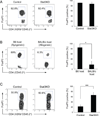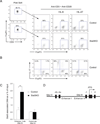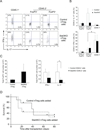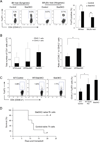STAT3 transcription factor promotes instability of nTreg cells and limits generation of iTreg cells during acute murine graft-versus-host disease
- PMID: 22921119
- PMCID: PMC3441059
- DOI: 10.1016/j.immuni.2012.05.027
STAT3 transcription factor promotes instability of nTreg cells and limits generation of iTreg cells during acute murine graft-versus-host disease
Abstract
Acute graft-versus-host disease (GvHD) is a major cause of mortality in allogeneic bone marrow transplantation (BMT), for which administration of FoxP3(+) regulatory T (Treg) cells has been proposed as a therapy. However, the phenotypic stability of Treg cells is controversial, and STAT3-dependent cytokines can inhibit FoxP3 expression. We assessed whether the elimination of STAT3 in T cells could limit the severity of GvHD. We found STAT3 limited FoxP3(+) Treg cell numbers following allogeneic BMT by two pathways: instability of natural Treg (nTreg) cells and inhibition of induced Treg (iTreg) cell polarization from naive CD4(+) T cells. Deletion of STAT3 within only the nTreg cell population was not sufficient to protect against lethal GvHD. In contrast, transfer of STAT3-deficient naive CD4(+) T cells increased FoxP3(+) Treg cells post-BMT and prevented lethality, suggesting that the consequence of STAT3 signaling may be greater for iTreg rather than nTreg cells during GvHD.
Copyright © 2012 Elsevier Inc. All rights reserved.
Figures







Similar articles
-
Instability of Foxp3 expression limits the ability of induced regulatory T cells to mitigate graft versus host disease.Clin Cancer Res. 2011 Jun 15;17(12):3969-83. doi: 10.1158/1078-0432.CCR-10-3347. Epub 2011 May 10. Clin Cancer Res. 2011. PMID: 21558402 Free PMC article.
-
Role of STAT3 in CD4+CD25+FOXP3+ regulatory lymphocyte generation: implications in graft-versus-host disease and antitumor immunity.J Immunol. 2007 Dec 1;179(11):7593-604. doi: 10.4049/jimmunol.179.11.7593. J Immunol. 2007. PMID: 18025205
-
Host natural killer T cells induce an interleukin-4-dependent expansion of donor CD4+CD25+Foxp3+ T regulatory cells that protects against graft-versus-host disease.Blood. 2009 Apr 30;113(18):4458-67. doi: 10.1182/blood-2008-06-165506. Epub 2009 Feb 12. Blood. 2009. PMID: 19221040 Free PMC article.
-
NKT cells, Treg, and their interactions in bone marrow transplantation.Eur J Immunol. 2010 Jul;40(7):1862-9. doi: 10.1002/eji.201040394. Eur J Immunol. 2010. PMID: 20583031 Free PMC article. Review.
-
Natural and expanded CD4(+)CD25(+) regulatory T cells in bone marrow transplantation.Biol Blood Marrow Transplant. 2011 Jan;17(1 Suppl):S58-62. doi: 10.1016/j.bbmt.2010.10.020. Biol Blood Marrow Transplant. 2011. PMID: 21195311 Free PMC article. Review. No abstract available.
Cited by
-
Donor T cell STAT3 deficiency enables tissue PD-L1-dependent prevention of graft-versus-host disease while preserving graft-versus-leukemia activity.J Clin Invest. 2023 Aug 1;133(15):e165723. doi: 10.1172/JCI165723. J Clin Invest. 2023. PMID: 37526084 Free PMC article.
-
Role of STAT3 in regulatory T lymphocyte plasticity during acute graft-vs.-host-disease.JAKSTAT. 2013 Oct 1;2(4):e24529. doi: 10.4161/jkst.24529. Epub 2013 Apr 16. JAKSTAT. 2013. PMID: 24498538 Free PMC article.
-
Increased mitochondrial apoptotic priming of human regulatory T cells after allogeneic hematopoietic stem cell transplantation.Haematologica. 2014 Sep;99(9):1499-508. doi: 10.3324/haematol.2014.104166. Epub 2014 May 23. Haematologica. 2014. PMID: 24859877 Free PMC article.
-
Next generation treatment of acute graft-versus-host disease.Leukemia. 2014 Dec;28(12):2283-91. doi: 10.1038/leu.2014.195. Epub 2014 Jun 18. Leukemia. 2014. PMID: 24938648 Review.
-
Targeting Janus Kinases and Signal Transducer and Activator of Transcription 3 to Treat Inflammation, Fibrosis, and Cancer: Rationale, Progress, and Caution.Pharmacol Rev. 2020 Apr;72(2):486-526. doi: 10.1124/pr.119.018440. Pharmacol Rev. 2020. PMID: 32198236 Free PMC article. Review.
References
Publication types
MeSH terms
Substances
Grants and funding
LinkOut - more resources
Full Text Sources
Other Literature Sources
Medical
Molecular Biology Databases
Research Materials
Miscellaneous

